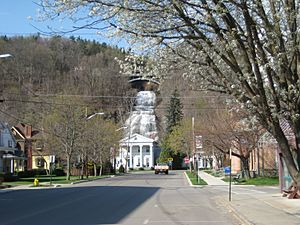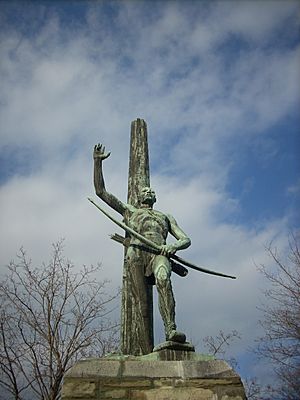Montour family facts for kids
The Montour family was a group of important people in colonial New York and Pennsylvania long ago. They were part Native American and part French. This family was very active before and during the American Revolution.
The family is known by the name "Montour" because of the Iroquois custom. In Iroquois culture, family lines are traced through the mother's side.
Contents
- Madam Montour: A Key Interpreter
- Andrew Montour: Soldier and Leader
- Margaret Montour: "French Margaret"
- Lewis Montour
- Catherine Montour: "French Catherine"
- Esther Montour: "Queen Esther"
- Mary Montour
- Roland Montour
- "Stuttering John" Montour
- John Montour (Andrew's Son)
- Nicholas Montour
- Simplified Family Tree
- Places Named After the Montour Family
- See also
Madam Montour: A Key Interpreter
Madam Montour (born around 1667, died about 1753) was a very important person in the Montour family. We don't have all the details about her life, and some information is different depending on the source. Even her first name is not fully certain.
She once said that she was born in Canada. Her father was a French gentleman who had been a governor there. When she was about ten years old, she was captured by warriors from the Five Nations (part of the Iroquois group). They took her to their lands and raised her just like their own children.
Today, experts believe she was born Élisabeth (or Isabelle) Couc in Trois-Rivières, Quebec. Her father was Pierre Couc, and her mother, Marie Mitouamegoukoue, was an Algonquin woman.
Madam Montour was married three times. Her last husband was an Oneida man named Carondawanna. He later took the name "Robert Hunter" after the Governor of New York. Madam Montour and Carondawanna had several children:
- Andrew (also called Sattelihu)
- Margaret, known as French Margaret
- A daughter, who might have been named Catherine
- Lewis (also called Tau-weson)
- Henry (some sources say Henry and Andrew were the same person)
Her husband was killed in a battle around 1729. After he died, Madam Montour and her family moved to a place called Otstonwakin. This area is now known as Montoursville, Pennsylvania.
Madam Montour was a skilled interpreter. She helped people communicate during important meetings. For example, she interpreted at Albany in 1711 and at Philadelphia in 1727. Her skills were so valuable that in 1719, officials decided she should be paid as much as a man.
Andrew Montour: Soldier and Leader
Andrew Montour (born around 1720, died 1772) was Madam Montour's oldest son. He became a captain for the British in 1754 during the French and Indian War. Later, he led a group of fighters in Ohio in 1764 during Pontiac's War.
The government in Pennsylvania gave him land. Andrew Montour married Sally Ainse. His son, John, fought for the colonists in the American Revolution. Another son, Nicholas, became a successful businessman and landowner in Canada.
Margaret Montour: "French Margaret"
Margaret Montour (born 1690), also known as French Margaret, was Madam Montour's oldest daughter. She married an Iroquois man named Katarioniecha, also called Peter Quebeck, who was a Mohawk.
They lived in a village known as "French Margaret's Town." This village was located where Lycoming Creek meets the west branch of the Susquehanna River. Today, this area is Williamsport, Pennsylvania. Margaret and Peter had at least five children:
- Catherine (French Catherine)
- Esther (Queen Esther)
- Nicholas
- A son who died around 1753 fighting the Creeks
- Mary, or Molly
Just like her mother, Margaret attended important meetings and often helped by interpreting.
Lewis Montour
Lewis Montour, a son of Madam Montour, was killed during the French and Indian War.
Catherine Montour: "French Catherine"

Catherine Montour (born 1710, died about 1780), also called French Catherine, was the daughter of French Margaret. She married Thomas Huston or Hudson. Their children were Roland, John, Amochol, and Belle.
Catherine lived in a large village at the top of Seneca Lake, New York. This village was called Shequaga, or Catherine's Town.
Esther Montour: "Queen Esther"
Esther Montour (born around 1720), known as Queen Esther, was the oldest daughter of French Margaret. She married Echogohund, who was a chief of the Munsee Delawares. After his death, she became their leader.
Her home was in Sheshequin, which is now Ulster Township, Bradford County, Pennsylvania. During the American Revolution, some reports say she led a group of warriors at the Battle of Wyoming in 1778. It is said that she was very angry because her son had died the day before.
Some stories claim she took part in harsh actions against enemies. However, other sources disagree. They say that reports of such actions might have been propaganda (information spread to influence opinions). Or, they suggest that Esther did not participate in those events. There are different ideas about how she died, with some saying she was killed in 1778 and others saying she lived until around 1800.
Mary Montour
Mary Montour was the daughter of French Margaret Montour. She married Kanaghragait, also known as "The White Mingo." Mary was baptized by a Catholic priest in Philadelphia.
In 1791, she moved with the Moravian mission from New Salem to Canada. Mary was very good with languages. She could speak English, French, Mohawk (her first language), Wyandot, Ottawa, Chippewa, Shawnese, and Delaware.
Roland Montour
Roland Montour (died around 1780), also spelled Rowland, was the oldest son of Catherine Montour. He was married to a daughter of the Seneca chief Sayenqueraghta.
Roland was involved in the American Revolution and supported the British side. He took part in a raid that captured a man named Benjamin Gilbert.
It is believed that he died in September 1780 in Painted Post, New York. He may have died from wounds he received in the Sugarloaf massacre in Pennsylvania. However, some sources say he lived for several years after that event.
"Stuttering John" Montour
John Montour (died about 1830), also known as "Stuttering John", was the son of Catherine Montour. He was Roland's younger brother. He died around 1830 in Big Tree, New York.
John Montour (Andrew's Son)
John Montour (born 1744, died 1788) was the son of Andrew Montour. He fought for the British in the American Revolution until 1778. At that time, he was put in prison in Detroit by Henry Hamilton for helping some prisoners escape. After this, he changed sides and supported the Colonists.
His mother was a Delaware woman. She was the granddaughter of Sassoonam.
Nicholas Montour
Nicholas Montour (born 1756, died 1808) was the son of Andrew Montour and Sally Ainse. He was a fur trader, a landowner (seigneur), and an important political figure in Lower Canada.
Simplified Family Tree
Many details about the Montour family tree are not fully clear. This chart shows some possible connections.
| Family of Madam Montour (simplified) | |||||||||||||||||||||||||||||||||||||||||||||||||||||||||||||||||||||||||||||||||||||||||||||||||||||||||||||||||||||||||||||||||||||||||||||||||||||||||||||||||||||||||||||||||||||||||||||||||||||||||||||||||||||||||||||||||||||||||||||||||||||||||||||||||||||||||||||||||||||||||||||||||||||||||||||||||||||||||||||||||||||||||||||||||||||||||||||||||||||||||||||||
|---|---|---|---|---|---|---|---|---|---|---|---|---|---|---|---|---|---|---|---|---|---|---|---|---|---|---|---|---|---|---|---|---|---|---|---|---|---|---|---|---|---|---|---|---|---|---|---|---|---|---|---|---|---|---|---|---|---|---|---|---|---|---|---|---|---|---|---|---|---|---|---|---|---|---|---|---|---|---|---|---|---|---|---|---|---|---|---|---|---|---|---|---|---|---|---|---|---|---|---|---|---|---|---|---|---|---|---|---|---|---|---|---|---|---|---|---|---|---|---|---|---|---|---|---|---|---|---|---|---|---|---|---|---|---|---|---|---|---|---|---|---|---|---|---|---|---|---|---|---|---|---|---|---|---|---|---|---|---|---|---|---|---|---|---|---|---|---|---|---|---|---|---|---|---|---|---|---|---|---|---|---|---|---|---|---|---|---|---|---|---|---|---|---|---|---|---|---|---|---|---|---|---|---|---|---|---|---|---|---|---|---|---|---|---|---|---|---|---|---|---|---|---|---|---|---|---|---|---|---|---|---|---|---|---|---|---|---|---|---|---|---|---|---|---|---|---|---|---|---|---|---|---|---|---|---|---|---|---|---|---|---|---|---|---|---|---|---|---|---|---|---|---|---|---|---|---|---|---|---|---|---|---|---|---|---|---|---|---|---|---|---|---|---|---|---|---|---|---|---|---|---|---|---|---|---|---|---|---|---|---|---|---|---|---|---|---|---|---|---|---|---|---|---|---|---|---|---|---|---|---|---|---|---|---|---|---|---|---|---|---|---|---|---|---|---|---|---|---|---|---|---|---|---|---|---|---|---|---|---|---|---|---|---|---|---|---|---|
|
|||||||||||||||||||||||||||||||||||||||||||||||||||||||||||||||||||||||||||||||||||||||||||||||||||||||||||||||||||||||||||||||||||||||||||||||||||||||||||||||||||||||||||||||||||||||||||||||||||||||||||||||||||||||||||||||||||||||||||||||||||||||||||||||||||||||||||||||||||||||||||||||||||||||||||||||||||||||||||||||||||||||||||||||||||||||||||||||||||||||||||||||
Places Named After the Montour Family
Many places are named in honor of members of the Montour family. These include:
- Catharine, New York
- Catharine Creek
- Montour County, Pennsylvania
- Montour Ridge, Montour County
- Montour Township, in Columbia County, Pennsylvania
- Montour, New York
- Montour Falls, New York
- Montour Run, a creek in Columbia County, Pennsylvania
- Montour's Island, in Allegheny County, Pennsylvania
- Montoursville, Pennsylvania
- Queen Catharine's Marsh, New York
- Queen Esther's Rock, in the village of Wyoming, Pennsylvania, near the site of the Battle of Wyoming
See also


